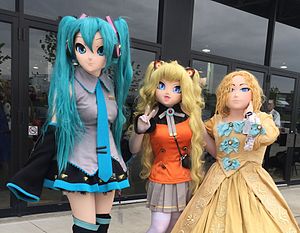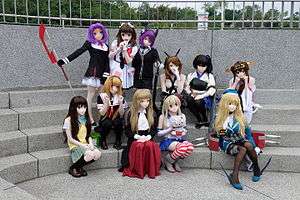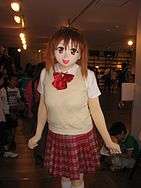Animegao kigurumi
Animegao kigurumi, known colloquially as kigurumi, kigu or occasionally doller and kig, is a type of cosplay which uses a masked character costume to portray anime or cartoon characters in the real world. The face of the performer is fully covered with a stylized mask, and the costume of the character is worn. Used in stage shows, the concept of animegao kigurumi was then adopted by cosplayers, who made custom masks of various characters. In Japan, most cosplayers refer to this style as animegao (アニメ顔, "anime face"), while performers are sometimes called "dollers". It is still a very minor part of the cosplay scene in Japan, though around 2005, it began attracting attention elsewhere, including the North America and Europe.[1]

.jpg)

As with other kinds of cosplay, many hobbyists have costumes of established characters from games or animations. The characters are usually female, and commonly human, although kigurumi characters of other races and genders do exist, including male (such as Kenshin Himura from Rurouni Kenshin), mechanical (such as Gundam Wing), elfin (such as Deedlit or Pirotess from Lodoss), and demonic (such as Inuyasha from the anime of the same name). Some kigurumi are original characters created by the performer. Both men and women wear kigurumi.[2][3]
By wearing a body suit and mask, kigurumi cosplayers are able to get closer to the appearance of the original character,[2][3] especially in the case of animal characters or highly stylised characters. In animegao kigurumi, the performer playing a humanoid anime character wears a flesh-coloured body suit (a zentai suit known as a hadatai) and matching mask usually moulded from clay or fiberglass composites.[1] The body suit allows them less-detailed skin features, on the level of animated characters, and the mask allows a similar level of facial features. Some hobbyists obtain masks from established hobbyist mask studios.
Though this term originated as animegao, the original Japanese term is not used to describe masks based on anime characters. Instead, the term kigurumi (着ぐるみ) is used by most performers.
Use of animegao kigurumi
While kigurumi is largely used in stage shows and by hobbyists, it has extended into the acts of other performers. DJ Minami Momochi performs in such an outfit, American photographer Laurie Simmons featured them in a photo series,[4] and Japanese fashion model Lulu Hashimoto incorporates them in her outfits.[5] Kigurumi cafes have also operated in Japan, where waitresses are dressed in costume.[6]
 This exemplary doller leaves no part of their skin exposed
This exemplary doller leaves no part of their skin exposed Kigurumi of Love Live! characters
Kigurumi of Love Live! characters
See also
References
| Wikimedia Commons has media related to Animegao. |
- Vidani, Peter. "Animegao FAQ". animegao.tumblr.com. Retrieved 2017-07-10.
- Lunair, Iliana (12 January 2020). "Ausstellung in Tokyo entführt in die Welt der Kigurumi-Masken". Sumikai (in German). Retrieved 18 June 2020.
- "Hyokkame Solo Exhibition: Discover The Surreal and Kawaii World of Artistic Kigurumi Masks". grape. 11 January 2020. Retrieved 18 June 2020.
- https://www.chicagotribune.com/entertainment/museums/ct-ent-laurie-simmons-photos-mca-0228-story.html
- https://www.reuters.com/article/us-japan-dollmodel/meet-lulu-hashimoto-the-living-doll-fashion-model-idUSKCN1B40QH
- "Garçonetes usam cabeças gigantes de pelúcia em bar no Japão". Galileu. Editora Globo S/A. 2 November 2012. Retrieved 3 April 2019.